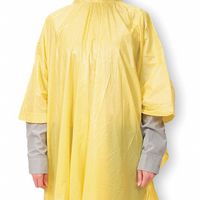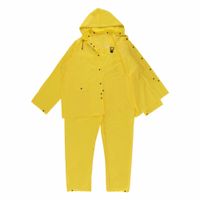Call +(254) 703 030 000 / 751 483 999 / 721 704 777
.....Read More
Frequently Asked Questions
What materials are used in rainwear to make it waterproof?
Rainwear is designed to keep the wearer dry by using materials that are either inherently waterproof or treated to repel water. Here are some common materials and technologies used in rainwear:
1. **Gore-Tex**: A popular waterproof, breathable fabric membrane that allows vapor to escape while preventing water from entering. It is often used in high-performance outdoor gear.
2. **Polyurethane (PU) Coating**: A synthetic material applied to fabrics to create a waterproof barrier. It is lightweight and flexible, making it suitable for rain jackets and ponchos.
3. **Polyvinyl Chloride (PVC)**: A plastic material used in raincoats and ponchos. It is completely waterproof but lacks breathability, which can lead to discomfort in warm conditions.
4. **Nylon and Polyester with DWR**: These synthetic fabrics are often treated with a Durable Water Repellent (DWR) finish, which causes water to bead up and roll off the surface. While not inherently waterproof, the DWR treatment enhances their water resistance.
5. **Rubber**: Traditionally used in rain boots and some raincoats, rubber is naturally waterproof but heavy and non-breathable.
6. **Waxed Cotton**: A natural fabric treated with wax to repel water. It offers a classic look and is breathable, but requires regular re-waxing to maintain its waterproof properties.
7. **eVent**: Similar to Gore-Tex, eVent is a waterproof, breathable fabric that allows sweat to escape while keeping rain out. It is used in high-performance outdoor clothing.
8. **SympaTex**: A waterproof, windproof, and breathable membrane that is often used in eco-friendly rainwear due to its recyclable nature.
These materials and technologies are often combined to balance waterproofing with breathability, comfort, and durability, catering to various needs and preferences in rainwear.
How do I choose the right size for rainwear?
To choose the right size for rainwear, start by considering the intended use and layering needs. If you plan to wear the rainwear over bulky clothing or layers, opt for a size larger than your usual clothing size to ensure comfort and mobility. Check the manufacturer's sizing chart, as sizes can vary between brands. Measure your chest, waist, hips, and inseam, and compare these measurements to the chart to find the best fit.
Consider the fit type: a relaxed fit offers more room for layering, while a slim fit provides a more tailored look. Pay attention to the length of the sleeves and the hem; they should be long enough to cover your wrists and hips, respectively, without restricting movement. Look for adjustable features like cuffs, hems, and hoods, which can help customize the fit.
Try on the rainwear, if possible, and move around to ensure it doesn’t restrict your movement. Check for comfort in the shoulders, chest, and back, as these areas are crucial for mobility. Ensure the rainwear is not too tight, as this can limit movement and cause discomfort, especially when active.
Consider the type of rainwear material, as some fabrics may have less stretch. If purchasing online, read customer reviews for insights on fit and sizing. Finally, consider the return policy, as this provides flexibility if the size isn’t right.
Can rainwear be breathable and waterproof at the same time?
Yes, rainwear can be both breathable and waterproof at the same time. This is achieved through advanced fabric technologies that allow moisture vapor to escape while preventing liquid water from penetrating. Materials like Gore-Tex, eVent, and other similar membranes are designed with microscopic pores that are small enough to block water droplets but large enough to allow water vapor from sweat to pass through. This dual functionality is crucial for comfort, especially during physical activities, as it helps regulate body temperature and reduces the clammy feeling associated with non-breathable rainwear. Additionally, these fabrics often have a Durable Water Repellent (DWR) coating on the outer layer to enhance water resistance.
How do I care for and maintain my rainwear?
To care for and maintain your rainwear, follow these steps:
1. **Read the Label**: Always start by checking the manufacturer's care instructions on the label for specific guidance.
2. **Regular Cleaning**: Clean your rainwear regularly to remove dirt and oils that can degrade the fabric. Use a gentle detergent designed for technical fabrics. Avoid fabric softeners and bleach, as they can damage waterproof coatings.
3. **Hand Wash or Gentle Cycle**: Hand wash your rainwear in lukewarm water or use a gentle cycle on your washing machine. Ensure all zippers and Velcro are fastened to prevent damage.
4. **Rinse Thoroughly**: Rinse well to remove all detergent residues, which can affect the fabric's breathability and waterproofing.
5. **Drying**: Air dry your rainwear by hanging it in a well-ventilated area. Avoid direct sunlight and high heat, which can damage the fabric. If the care label allows, tumble dry on low heat to help reactivate the DWR (Durable Water Repellent) coating.
6. **Reproofing**: Over time, the DWR coating may wear off. Reapply a DWR treatment when water no longer beads on the surface. Use a spray-on or wash-in product specifically designed for waterproof garments.
7. **Storage**: Store your rainwear in a cool, dry place. Avoid compressing it for long periods, as this can damage the fabric and reduce its effectiveness.
8. **Repairs**: Promptly repair any tears or damage using patches or repair tape designed for waterproof fabrics to maintain the garment's integrity.
9. **Avoid Contaminants**: Keep your rainwear away from oils, insect repellents, and other chemicals that can degrade the fabric.
By following these steps, you can extend the life and performance of your rainwear.
What is the difference between water-resistant and waterproof rainwear?
Water-resistant and waterproof rainwear differ primarily in their ability to repel water and the level of protection they offer against wet conditions.
Water-resistant rainwear is designed to resist water penetration to a certain degree but is not completely impervious to it. This type of rainwear is typically made from tightly woven fabrics that have been treated with a durable water repellent (DWR) coating. The DWR treatment causes water to bead up and roll off the surface, providing temporary protection against light rain or drizzle. However, in prolonged exposure to heavy rain, water-resistant garments may eventually allow moisture to seep through, as they are not fully sealed against water ingress.
Waterproof rainwear, on the other hand, offers a higher level of protection and is designed to be completely impervious to water. These garments are made from materials that are inherently waterproof, such as Gore-Tex or other similar membranes, which prevent water from penetrating the fabric. Additionally, waterproof rainwear often features fully taped or sealed seams, waterproof zippers, and storm flaps to ensure that no water can enter through the stitching or openings. This makes waterproof rainwear suitable for heavy rain and extended exposure to wet conditions.
In summary, the key difference lies in the level of water protection: water-resistant rainwear offers limited protection suitable for light rain, while waterproof rainwear provides comprehensive protection against heavy and prolonged rain.
Are there specific rainwear options for different types of outdoor activities?
Yes, there are specific rainwear options tailored for different types of outdoor activities, each designed to meet the unique demands of the activity while providing protection from rain.
1. **Hiking and Backpacking**: For these activities, lightweight and breathable rain jackets and pants are ideal. Look for options with ventilation features like pit zips to manage sweat. Waterproof and breathable fabrics such as Gore-Tex or eVent are popular choices.
2. **Cycling**: Cyclists benefit from rainwear that is form-fitting to reduce drag. Jackets with longer backs and sleeves accommodate the cycling position. Waterproof and windproof materials with reflective elements enhance visibility and safety.
3. **Running**: Runners need lightweight, breathable, and water-resistant jackets that allow for a full range of motion. Look for options with moisture-wicking properties and minimal bulk to avoid overheating.
4. **Fishing**: Anglers often require durable, waterproof gear that can withstand prolonged exposure to water. Bibs and jackets made from heavy-duty materials like PVC or rubberized fabrics are common, providing full coverage and protection.
5. **Mountaineering and Climbing**: These activities demand highly durable and waterproof gear that can withstand harsh conditions. Jackets and pants with reinforced areas, helmet-compatible hoods, and harness-friendly designs are essential.
6. **Casual Wear**: For everyday use, stylish raincoats or trench coats made from water-resistant materials offer protection while maintaining a fashionable appearance. These are often less technical but provide adequate protection for urban environments.
7. **Sailing**: Sailors need waterproof and windproof gear that can handle saltwater exposure. High-collared jackets with adjustable cuffs and hoods, along with waterproof trousers, are essential to stay dry and warm.
Each type of rainwear is designed with specific features to enhance performance and comfort in the respective activity, ensuring that users remain dry and protected in wet conditions.
How long does waterproof rainwear typically last?
The lifespan of waterproof rainwear typically ranges from 1 to 10 years, depending on several factors such as the quality of the material, frequency of use, maintenance, and environmental conditions. High-quality rainwear made from durable materials like Gore-Tex or eVent can last up to 10 years or more with proper care. These materials are designed to withstand harsh weather conditions and maintain their waterproof properties over time.
In contrast, rainwear made from less durable materials, such as polyurethane-coated fabrics, may only last 1 to 3 years, especially if used frequently or in challenging conditions. The frequency of use plays a significant role; rainwear used daily will naturally wear out faster than items used occasionally.
Proper maintenance is crucial for extending the lifespan of waterproof rainwear. Regular cleaning according to the manufacturer's instructions helps maintain the fabric's breathability and waterproofing. Reapplying a durable water repellent (DWR) coating periodically can also help restore water resistance. Storing rainwear in a cool, dry place away from direct sunlight prevents material degradation.
Environmental factors, such as exposure to UV rays, saltwater, and pollutants, can accelerate wear and tear. Rainwear used in urban environments may degrade faster due to pollution, while exposure to saltwater can damage the fabric and reduce its lifespan.
Ultimately, the longevity of waterproof rainwear depends on the balance of these factors. Investing in high-quality materials, following proper care instructions, and minimizing exposure to harsh conditions can significantly extend the life of rainwear, ensuring it remains effective for many years.




